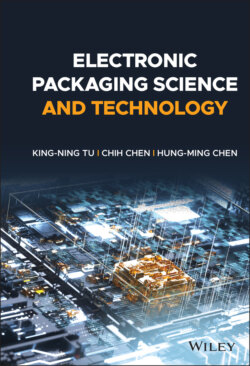Читать книгу Electronic Packaging Science and Technology - King-Ning Tu - Страница 2
Table of Contents
Оглавление1 Cover
4 Preface
5 1 Introduction 1.1 Introduction 1.2 Impact of Moore’s Law on Si Technology 1.3 5G Technology and AI Applications 1.4 3D IC Packaging Technology 1.5 Reliability Science and Engineering 1.6 The Future of Electronic Packaging Technology 1.7 Outline of the Book References
6 Part I: 2 Cu‐to‐Cu and Other Bonding Technologies in Electronic Packaging 2.1 Introduction 2.2 Wire Bonding 2.3 Tape‐Automated Bonding 2.4 Flip‐Chip Solder Joint Bonding 2.5 Micro‐Bump Bonding 2.6 Cu‐to‐Cu Direct Bonding 2.7 Hybrid Bonding 2.8 Reliability – Electromigration and Temperature Cycling Tests Problems References 3 Randomly‐Oriented and (111) Uni‐directionally‐Oriented Nanotwin Copper 3.1 Introduction 3.2 Formation Mechanism of Nanotwin Cu 3.3 In Situ Measurement of Stress Evolution During Nanotwin Deposition 3.4 Electrodeposition of Randomly Oriented Nanotwinned Copper 3.5 Formation of Unidirectionally (111)‐oriented Nanotwin Copper 3.6 Grain Growth in [111]‐Oriented nt‐Cu 3.7 Uni‐directional Growth of η‐Cu6Sn5 in Microbumps on (111) Oriented nt‐Cu 3.8 Low Thermal‐Budget Cu‐to‐Cu Bonding Using [111]‐Oriented nt‐Cu 3.9 Nanotwin Cu RDL for Fanout Package and 3D IC Integration Problems References 4 Solid–Liquid Interfacial Diffusion Reaction (SLID) Between Copper and Solder 4.1 Introduction 4.2 Kinetics of Scallop‐Type IMC Growth in SLID 4.3 A Simple Model for the Growth of Mono‐Size Hemispheres 4.4 Theory of Flux‐Driven Ripening 4.5 Measurement of the Nano‐channel Width Between Two Scallops 4.6 Extremely Rapid Grain Growth in Scallop‐Type Cu6Sn5 in SLID Problems References 5 Solid‐State Reactions Between Copper and Solder 5.1 Introduction 5.2 Layer‐Type Growth of IMC in Solid‐State Reactions 5.3 Wagner Diffusivity 5.4 Kirkendall Void Formation in Cu3Sn 5.5 Sidewall Reaction to Form Porous Cu3Sn in μ‐Bumps 5.6 Effect of Surface Diffusion on IMC Formation in Pillar‐Type μ‐Bumps Problems References
7 Part II: 6 Essence of Integrated Circuits and Packaging Design 6.1 Introduction 6.2 Transistor and Interconnect Scaling 6.3 Circuit Design and LSI 6.4 System‐on‐Chip (SoC) and Multicore Architectures 6.5 System‐in‐Package (SiP) and Package Technology Evolution 6.6 3D IC Integration and 3D Silicon Integration 6.7 Heterogeneous Integration: An Introduction Problems References 7 Performance, Power, Thermal, and Reliability 7.1 Introduction 7.2 Field‐Effect Transistor and Memory Basics 7.3 Performance: A Race in Early IC Design 7.4 Trend in Low Power 7.5 Trade‐off between Performance and Power 7.6 Power Delivery and Clock Distribution Networks 7.7 Low‐Power Design Architectures 7.8 Thermal Problems in IC and Package 7.9 Signal Integrity and Power Integrity (SI/PI) 7.10 Robustness: Reliability and Variability Problems References 8 2.5D/3D System‐in‐Packaging Integration 8.1 Introduction 8.2 2.5D IC: Redistribution Layer (RDL) and TSV‐Interposer 8.3 2.5D IC: Silicon, Glass, and Organic Substrates 8.4 2.5D IC: HBM on Silicon Interposer 8.5 3D IC: Memory Bandwidth Challenge for High‐Performance Computing 8.6 3D IC: Electrical and Thermal TSVs 8.7 3D IC: 3D‐Stacked Memory and Integrated Memory Controller 8.8 Innovative Packaging for Modern Chips/Chiplets 8.9 Power Distribution for 3D IC Integration 8.10 Challenge and Trend Problems References
8 Part III: 9 Irreversible Processes in Electronic Packaging Technology 9.1 Introduction 9.2 Flow in Open Systems 9.3 Entropy Production 9.4 Cross‐Effects in Irreversible Processes 9.5 Cross‐Effect Between Atomic Diffusion and Electrical Conduction 9.6 Irreversible Processes in Thermomigration 9.7 Cross‐Effect Between Heat Conduction and Electrical Conduction Problems References 10 Electromigration 10.1 Introduction 10.2 To Compare the Parameters in Atomic Diffusion and Electric Conduction 10.3 Basic of Electromigration 10.4 Current Crowding and Electromigration in 3‐Dimensional Circuits 10.5 Joule Heating and Heat Dissipation Problems References 11 Thermomigration 11.1 Introduction 11.2 Driving Force of Thermomigration 11.3 Analysis of Heat of Transport, Q* 11.4 Thermomigration Due to Heat Transfer Between Neighboring Pairs of Powered and Unpowered Solder Joints Problems References 12 Stress‐Migration 12.1 Introduction 12.2 Chemical Potential in a Stressed Solid 12.3 Stoney’s Equation of Biaxial Stress in Thin Films 12.4 Diffusional Creep 12.5 Spontaneous Sn Whisker Growth at Room Temperature 12.6 Comparison of Driving Forces Among Electromigration, Thermomigration, and Stress‐Migration Problems References 13 Failure Analysis 13.1 Introduction 13.2 Microstructure Change with or Without Lattice Shift 13.3 Statistical Analysis of Failure 13.4 A Unified Model of MTTF for Electromigration, Thermomigration, and Stress‐Migration 13.5 Failure Analysis in Mobile Technology Problems References 14 Artificial Intelligence in Electronic Packaging Reliability 14.1 Introduction 14.2 To Change Time‐Dependent Event to Time‐Independent Event 14.3 To Deduce MTTF from Mean Microstructure Change to Failure 14.4 Summary
9 Index
